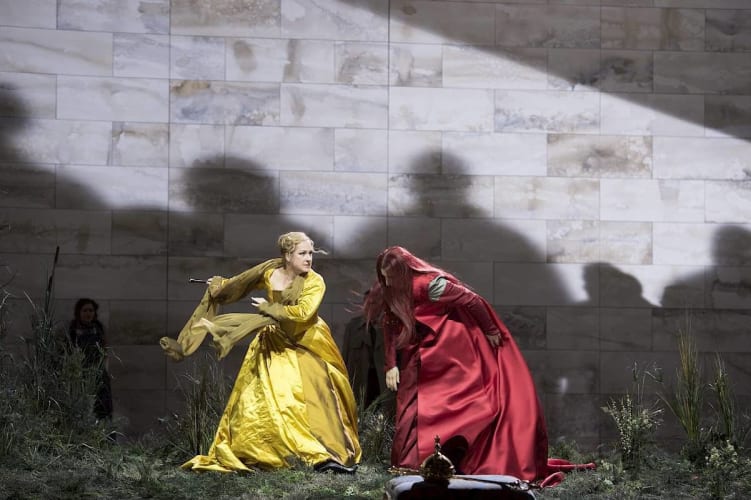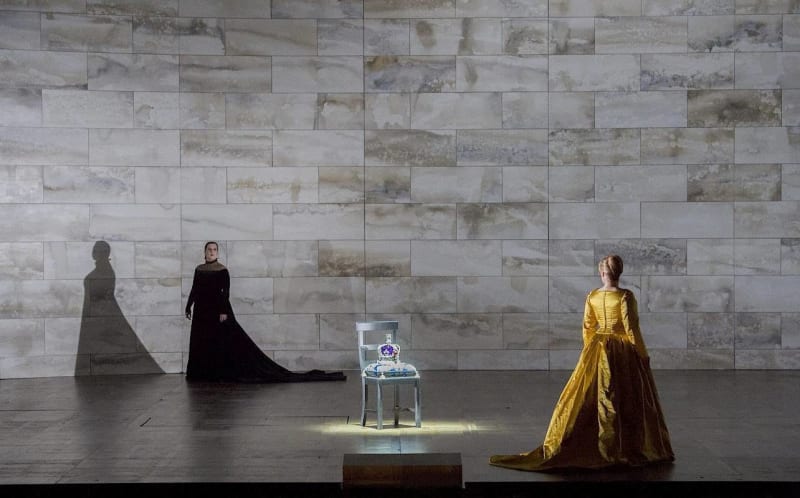Everybody on stage, backstage and in the auditorium is wearing masks. Zurich’s opera house is packed to the rafters and there is no social distancing. The only people not wearing masks are the six lead singers. The orchestra is not in the orchestra pit. It is in another building, a mile away. The synchronisation of the sound is an amazing feat.
Friedrich Schiller wrote his political thriller in 1800. Maria Stuarda is the one play by him which is regularly revived on the English stage, offering, as it does, two great roles.
Gaetano Donizetti’s bel canto opera, based on Schiller, premièred in Naples in 1834. The King of Naples banned it. He deemed a Protestant Queen beheading a Roman Catholic Queen was totally unacceptable for the general public. The opera took a long time to resurface and wasn’t in fact seen until the following century.
Queen Elizabeth I imprisoned Mary, Queen of Scots, in Fotheringhay Castle for 19 years, fearing that Catholics would put her on the throne. She knew Mary would have to be executed eventually; but she constantly wavered, fearing the repercussions.
David Alden’s production, conducted by Enrique Mazzola, opens with mime, instantly and effectively establishing what the play is going to be all about. The two queens silently cross the stage, circling each other, all the while eying the coronation crown which has been placed on a pedestal centre-stage.
The queens are identified by colour. Mary (Diana Damrau) wears a yellow gown. Elizabeth (Salome Jicia) wears a red gown and a red wig. Elizabeth dominates the first act. Mary dominates the rest of the opera. There are lots of opportunities for two great sopranos to shine and Damrau and Jicia take them.
Donizetti is clearly on Mary’s side who is much more sympathetically portrayed than Elizabeth. Mary is not the proud and arrogant person the queen accuses her of being. Elizabeth, who does not disguise her jealousy and hostility, loses the moral high ground.
The more the Earl of Leicester pleads for Mary’s life, the more Elizabeth is convinced he loves Mary more than he loves her and the more determined she becomes to execute Mary. Paolo Fanale comes across as far too sweet, far too naïve and far too boyish to be convincing as Leicester and the chemistry between him and the two queens is nil.
Andre Courville, who is cast as Cecil, the courtier who persuades Elizabeth to sign the death warrant, carries an enormous executioner’s axe around all evening, advertising how evil he is.
The two queens never met in real life. Schiller’s imagined face to face confrontation between them is one of the great scenes of European romantic drama. Leicester engineers the meeting, feeling certain that Elizabeth will be moved to pity and will pardon Mary. Instead, Mary is goaded into losing her head and insulting Elizabeth, calling her a whore and a bastard.
The high spot in this production is this meeting and the splendid act one finale. The moving act two finale, Mary’s execution, is not as effective, hampered by Alden’s over-stylized staging.


